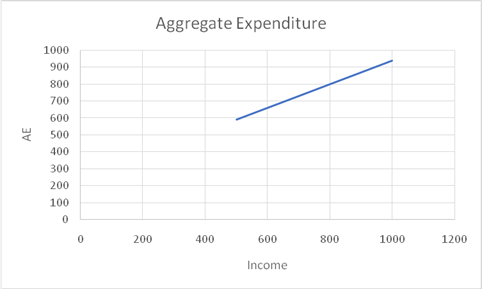
(a)
| Y | C | I | G | X |
| $ 500 | $500 | $10 | $20 | $60 |
| $600 | $590 | $10 | $20 | $40 |
| $700 | $680 | $10 | $20 | $20 |
| $800 | $770 | $10 | $20 | $0 |
| $900 | $860 | $10 | $20 | -$20 |
| $1000 | $950 | $10 | $20 | -$40 |
The value of MPC.
Answer to Problem 6E
| Y | C | MPC |
| $500 | $500 | |
| $600 | $590 | 0.9 |
| $700 | $680 | 0.9 |
| $800 | $770 | 0.9 |
| $900 | $860 | 0.9 |
| $1000 | $950 | 0.9 |
Explanation of Solution
MPC =
Wherein, Change in Income =
| Y | C | MPC |
| $500 | $500 | |
| $600 | $590 | 0.9 |
| $700 | $680 | 0.9 |
| $800 | $770 | 0.9 |
| $900 | $860 | 0.9 |
| $1000 | $950 | 0.9 |
MPC − The additional consumption resulting from an additional unit of income.
(b)
To write:
| Y | C | I | G | X |
| $ 500 | $500 | $10 | $20 | $60 |
| $600 | $590 | $10 | $20 | $40 |
| $700 | $680 | $10 | $20 | $20 |
| $800 | $770 | $10 | $20 | $0 |
| $900 | $860 | $10 | $20 | -$20 |
| $1000 | $950 | $10 | $20 | -$40 |
The value of MPS.
Answer to Problem 6E
The value of MPS is 0.10.
Explanation of Solution
Since income can only be either consumed or saved, therefore it can be written as
Y = C+S
Differentiating both sides with respect to Y
1 =
Thus, MPS =
In this case,
MPS =
MPS = 0.1
MPS − The additional savings arising out of an additional unit of income.
(c)
| Y | C | I | G | X |
| $ 500 | $500 | $10 | $20 | $60 |
| $600 | $590 | $10 | $20 | $40 |
| $700 | $680 | $10 | $20 | $20 |
| $800 | $770 | $10 | $20 | $0 |
| $900 | $860 | $10 | $20 | -$20 |
| $1000 | $950 | $10 | $20 | -$40 |
The value of MPI.
Answer to Problem 6E
| Y | I |
| $ 500 | $10 |
| $600 | $10 |
| $700 | $10 |
| $800 | $10 |
| $900 | $10 |
| $1000 | $10 |
The MPI is zero.
Explanation of Solution
In this case, the investment is not changing with income level. It is fixed. Hence, the marginal propensity to invest is zero.
MPI − The additional investment arising out of an additional unit of income.
(d)
| Y | C | I | G | X |
| $ 500 | $500 | $10 | $20 | $60 |
| $600 | $590 | $10 | $20 | $40 |
| $700 | $680 | $10 | $20 | $20 |
| $800 | $770 | $10 | $20 | $0 |
| $900 | $860 | $10 | $20 | -$20 |
| $1000 | $950 | $10 | $20 | -$40 |
The aggregate expenditure at each level of income.
Answer to Problem 6E
| Y | C | I | G | X | AE |
| $ 500 | $500 | $10 | $20 | $60 | $590 |
| $600 | $590 | $10 | $20 | $40 | $660 |
| $700 | $680 | $10 | $20 | $20 | $730 |
| $800 | $770 | $10 | $20 | $0 | $800 |
| $900 | $860 | $10 | $20 | -$20 | $870 |
| $1000 | $950 | $10 | $20 | -$40 | $940 |
Explanation of Solution
Aggregate expenditure at each level of income is consumption expenditure plus investment expenditure plus government expenditure and net exports.
Aggregate expenditure− The expenditure made by different sectors of the economy to goods and services and the net exports.
(e)
| Y | C | I | G | X |
| $ 500 | $500 | $10 | $20 | $60 |
| $600 | $590 | $10 | $20 | $40 |
| $700 | $680 | $10 | $20 | $20 |
| $800 | $770 | $10 | $20 | $0 |
| $900 | $860 | $10 | $20 | -$20 |
| $1000 | $950 | $10 | $20 | -$40 |
The aggregate expenditure graphs.
Answer to Problem 6E

Explanation of Solution
Aggregate Expenditure graph will be sloping upwards. This is due to the increase in level of aggregate expenditure.
| Y | C | I | G | X | AE |
| $ 500 | $500 | $10 | $20 | $60 | $590 |
| $600 | $590 | $10 | $20 | $40 | $660 |
| $700 | $680 | $10 | $20 | $20 | $730 |
| $800 | $770 | $10 | $20 | $0 | $800 |
| $900 | $860 | $10 | $20 | -$20 | $870 |
| $1000 | $950 | $10 | $20 | -$40 | $940 |
Aggregate expenditure− The expenditure made by different sectors of the economy to goods and services and the net exports.
Want to see more full solutions like this?
- Price P 1. Explain the distinction between outputs and outcomes in social service delivery 2. Discuss the Rawlsian theory of justice and briefly comment on its relevance to the political economy of South Africa. [2] [7] 3. Redistributive expenditure can take the form of direct cash transfers (grants) and/or in- kind subsidies. With references to the graphs below, discuss the merits of these two transfer types in the presence and absence of a positive externality. [6] 9 Quantity (a) P, MC, MB MSB MPB+MEB MPB P-MC MEB Quantity (6) MCarrow_forwardDon't use ai to answer I will report you answerarrow_forwardIf 17 Ps are needed and no on-hand inventory exists fot any of thr items, how many Cs will be needed?arrow_forward
- Exercise 5Consider the demand and supply functions for the notebooks market.QD=10,000−100pQS=900pa. Make a table with the corresponding supply and demand schedule.b. Draw the corresponding graph.c. Is it possible to find the price and quantity of equilibrium with the graph method? d. Find the price and quantity of equilibrium by solving the system of equations.arrow_forward1. Consider the market supply curve which passes through the intercept and from which the marketequilibrium data is known, this is, the price and quantity of equilibrium PE=50 and QE=2000.a. Considering those two points, find the equation of the supply. b. Draw a graph for this equation. 2. Considering the previous supply line, determine if the following demand function corresponds to themarket demand equilibrium stated above. QD=.3000-2p.arrow_forwardSupply and demand functions show different relationship between the price and quantities suppliedand demanded. Explain the reason for that relation and provide one reference with your answer.arrow_forward
- 13:53 APP 簸洛瞭對照 Vo 56 5G 48% 48% atheva.cc/index/index/index.html The Most Trusted, Secure, Fast, Reliable Cryptocurrency Exchange Get started with the easiest and most secure platform to buy, sell, trade, and earn Cryptocurrency Balance:0.00 Recharge Withdraw Message About us BTC/USDT ETH/USDT EOS/USDT 83241.12 1841.50 83241.12 +1.00% +0.08% +1.00% Operating norms Symbol Latest price 24hFluctuation B BTC/USDT 83241.12 +1.00% ETH/USDT 1841.50 +0.08% B BTC/USD illı 83241.12 +1.00% Home Markets Trade Record Mine О <arrow_forwardThe production function of a firm is described by the following equation Q=10,000L-3L2 where Lstands for the units of labour.a) Draw a graph for this equation. Use the quantity produced in the y-axis, and the units of labour inthe x-axis. b) What is the maximum production level? c) How many units of labour are needed at that point?arrow_forwardDon't use ai to answer I will report you answerarrow_forward

 Economics (MindTap Course List)EconomicsISBN:9781337617383Author:Roger A. ArnoldPublisher:Cengage Learning
Economics (MindTap Course List)EconomicsISBN:9781337617383Author:Roger A. ArnoldPublisher:Cengage Learning








